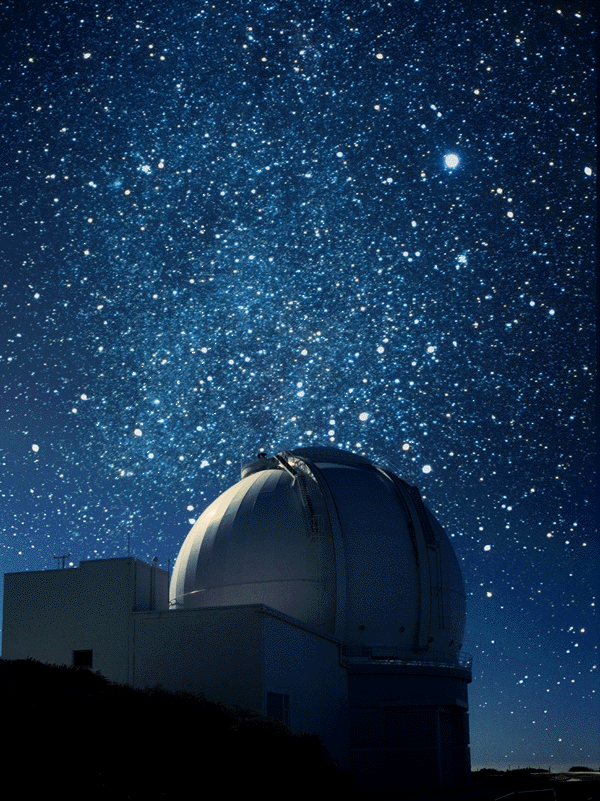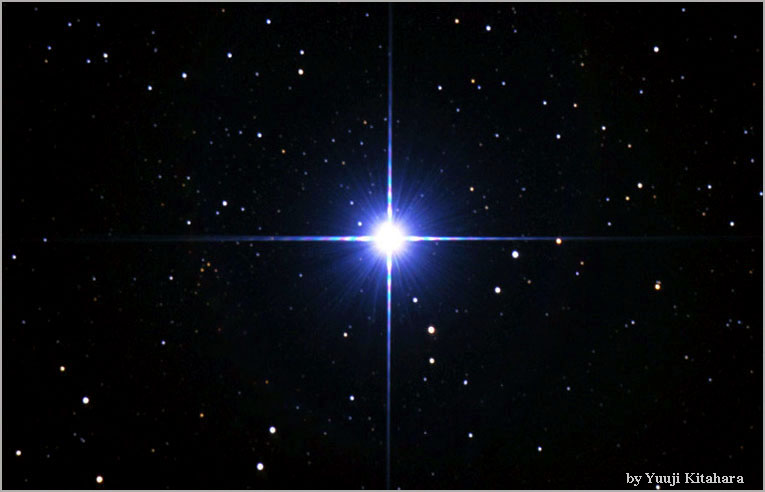
Sirius is the brightest star in the night sky with a visual apparent magnitude of −1.47, almost twice as bright as Canopus, the next brightest star. Pronounced /ˈsɪriəs/,[15] the name Sirius is derived from the Ancient Greek Σείριος.[16] The star has the Bayer designation α Canis Majoris (α CMa, or Alpha Canis Majoris). What the naked eye perceives as a single star is actually a binary star system, consisting of a white main sequence star of spectral type A1V, termed Sirius A, and a faint white dwarf companion of spectral type DA2, termed Sirius B.
Sirius appears bright due to both its intrinsic luminosity and its closeness to the Earth. At a distance of 2.6 parsecs (8.6 light-years), the Sirius system is one of our near neighbors. Sirius A is about twice as massive as the Sun and has an absolute visual magnitude of 1.42. It is 25 times more luminous than the Sun[7] but has a significantly lower luminosity than other bright stars such as Canopus or Rigel. The system is between 200 and 300 million years old.[7] It was originally composed of two bright bluish stars. The more massive of these, Sirius B, consumed its resources and became a red giant before shedding its outer layers and collapsing into its current state as a white dwarf around 120 million years ago.[7]
Sirius is also known colloquially as the "Dog Star", reflecting its prominence in its constellation, Canis Major (English: Big Dog).[17] It is the subject of more myth and folklore than any other star apart from the sun. The heliacal rising of Sirius marked the flooding of the Nile in Ancient Egypt and the 'Dog Days' of summer for the Ancient Greeks, while to the Polynesians it marked winter and was an important star for navigation around the Pacific Ocean.
Observational history
Sirius is recorded in the earliest astronomical records, known in Ancient Egypt as Sopdet (Greek: Sothis). During the era of the Middle Kingdom, Egyptians based their calendar on the heliacal rising of Sirius, namely the day it becomes visible just before sunrise after moving far enough away from the glare of the sun. This occurred just before the annual flooding of the Nile and the summer solstice,[18] after a 70 day absence from the skies.[19] The hieroglyph for Sothis features a star and a triangle. Sothis was identified with the great goddess Isis who formed a part of a trinity with her husband Osiris and their son Horus, while the 70 day period symbolised the passing of Isis and Osiris through the duat (Egyptian underworld).[19]
The Ancient Greeks believed that the appearance of Sirius heralded the hot and dry summer, and feared its effects on making plants wilt, men weaken and women become aroused.[20] Due to its brightness, Sirius would have been noted to twinkle more in the unsettled weather conditions of early summer. To Greek observers, this signified certain emanations which caused its malign influence. People suffering its effects were said to be astroboletos/αστροβολητος or 'star-struck'. It was described as 'burning' or 'flaming' in literature.[21] The season following the star's appearance came to be known as the Dog Days of summer.[22] The inhabitants of the island of Ceos in the Aegean Sea would offer sacrifices to Sirius and Zeus to bring cooling breezes, and would await the reappearance of the star in summer. If it rose clear, it would portend good fortune; if it was misty or faint then it foretold (or emanated) pestilence. Coins retrieved from the island from the third century BC feature dogs or stars with emanating rays, highlighting Sirius' importance.[23] The Romans celebrated the heliacal setting of Sirius around April 25, sacrificing a dog, along with incense, wine, and a sheep, to the goddess Robigo so that the star's emanations would not cause wheat rust on wheat crops that year.[24]
Ptolemy of Alexandria mapped the stars in Book VII and VIII of his Almagest, in which he used Sirius as the location for the globe's central meridian. He curiously depicted it as one of six red-coloured stars (see the Red controversy section below). The other five are, in fact, class M and K stars, such as Arcturus and Betelgeuse.[25]
Bright stars were important to the ancient Polynesians for navigation between the many islands and atolls of the Pacific Ocean. Low on the horizon, they acted as stellar compasses to assist mariners in charting courses to particular destinations. They also served as latitude markers; the declination of Sirius matches the latitude of the island of Fiji at 17°S and thus passes directly over the island each night.[26] Sirius served as the body of a 'Great Bird' constellation called Manu, with Canopus as the southern wingtip and Procyon the northern wingtip, which divided the Polynesian night sky into two hemispheres.[27] Just as the appearance of Sirius in the morning sky marked summer in Greece, so it marked the chilly onset of winter for the Māori, whose name Takurua described both the star and the season. Its culmination at the winter solstice was marked by celebration in Hawaii, where it was known as Ka'ulua 'Queen of Heaven'. Many other Polynesian names have been recorded, including Tau-ua in the Marquesas Islands, Rehua in New Zealand, and Aa and Hoku-Kauopae in Hawaii.[28]
Kinematics
In 1676, Edmond Halley spent a year on the island of Saint Helena in the South Atlantic surveying the southern stars. Some 40 years later in 1718 he discovered the proper motion of the hitherto presumed "fixed" stars after comparing his astrometric measurements with those given in Ptolemy's Almagest. Arcturus and Sirius were two noted to have moved significantly, the latter having progressed 30 arc minutes (about the diameter of the moon) southwards in 1800 years.[29]
In 1868, Sirius became the first star to have its velocity measured. Sir William Huggins examined the spectrum of this star and observed a noticeable red shift. He concluded that Sirius was receding from the Solar System at about 40 km/s.[30][31] Compared to the modern value of −7.6 km/s,[1] this is an overestimate, but it is notable for introducing the study of celestial radial velocities.
Discovery of a companion
In 1844, German astronomer Friedrich Bessel deduced from changes in the proper motion of Sirius that it had an unseen companion.[32] Nearly two decades later, on January 31, 1862, American telescope-maker and astronomer Alvan Graham Clark first observed the faint companion, which is now called Sirius B, or affectionately "the Pup".[33] The visible star is now sometimes known as Sirius A. Since 1894, some apparent orbital irregularities in the Sirius system have been observed, suggesting a third very small companion star, but this has never been definitely confirmed. The best fit to the data indicates a six-year orbit around Sirius A and a mass of only 0.06 solar masses. This star would be five to ten magnitudes fainter than the white dwarf Sirius B, which would account for the difficulty of observing it.[34] More recent observations have failed to confirm the existence of a third member of the Sirius system, but still have not completely ruled out the possibility that one exists too close to Sirius to be seen. An apparent "third star" observed in the 1920s seems to have been a background object.[35]
In 1915, Walter Sydney Adams, using a 60-inch (1.5 meter) reflector at Mount Wilson Observatory, observed the spectrum of Sirius B and determined that it was a faint whitish star.[36] This led astronomers to conclude that it was a white dwarf, the second to be discovered.[37] The diameter of Sirius A was first measured by Robert Hanbury Brown and Richard Q. Twiss in 1959 at Jodrell Bank using their stellar intensity interferometer.[38] In 2005, using the Hubble Space Telescope, astronomers determined that Sirius B has nearly the diameter of the Earth, 12,000 kilometers (7,500 miles), with a mass that is 98% of the Sun.[39][40][41][42]
Red controversy
In 150 AD, the astronomer Ptolemy described Sirius as reddish, along with five other stars, Betelgeuse, Antares, Aldebaran, Arcturus and Pollux, all of which are clearly of orange or red hue.[43] The discrepancy was first noted by amateur astronomer Thomas Barker, squire of Lyndon Hall in Rutland, who prepared a paper and spoke at a meeting of the Royal Society in London in 1760. The existence of other stars changing in brightness gave credence to the idea that some may change in colour too; Sir John Herschel noted this in 1839, possibly influenced by witnessing Eta Carinae two years earlier.[44] Thomas Jefferson Jackson See resurrected discussion on red Sirius with the publication of several papers in 1892, and a final summary in 1926.[45] He cited not only Ptolemy but also the poet Aratus, the orator Cicero, and general Germanicus as colouring the star red, though acknowledging that none of the latter three authors were astronomers, the last two merely translating Aratus' poem Phaenomena.[46] Seneca, too, had described Sirius as being of a deeper red colour than Mars.[47] However, not all ancient observers saw Sirius as red. The 1st century AD poet Marcus Manilius described it as "sea-blue", as did the 4th century Avienus.[48] It is the standard star for the color white in ancient China, and multiple records from the 2nd century BC up to the 7th century AD all describe Sirius as white in hue.[49][50]
In 1985, German astronomers Wolfhard Schlosser and Werner Bergmann published an account of an 8th century Lombardic manuscript, which contains De cursu stellarum ratio by St. Gregory of Tours. The Latin text taught readers how to determine the times of nighttime prayers from positions of the stars, and Sirius is described within as rubeola 'reddish'. The authors proposed this was further evidence Sirius B had been a red giant at the time.[51] However, other scholars replied that it was likely St. Gregory had been referring to Arcturus instead.[52][53]
The possibility that stellar evolution of either Sirius A or Sirius B could be responsible for this discrepancy has been rejected by astronomers on the grounds that the timescale of thousands of years is too short and that there is no sign of the nebulosity in the system that would be expected had such a change taken place.[54] An interaction with a third star, to date undiscovered, has also been proposed as a possibility for a red appearance.[55] Alternative explanations are either that the description as red is a poetic metaphor for ill fortune, or that the dramatic scintillations of the star when it was observed rising left the viewer with the impression that it was red. To the naked eye, it often appears to be flashing with red, white and blue hues when near the horizon.[54]

Visibility
With an apparent magnitude of −1.47, Sirius is the brightest star in the night sky, almost twice the brightness of the second brightest star, Canopus.[57] However, it is not as bright as the Moon, Venus, or Jupiter. Mercury and Mars are also brighter than Sirius at times.[58][59] Sirius can be seen from almost every inhabited region of the Earth's surface, with only those living north of 73 degrees unable to see it. However, it does not rise very high when viewed from some northern cities, reaching only 13° above the horizon from Saint Petersburg.[60] Sirius, along with Procyon and Betelgeuse, forms one of the three vertices of the Winter Triangle to observers in the Northern Hemisphere.[61] Due to its declination of roughly -17°,[1] Sirius is a circumpolar star from latitudes south of 73° S. From the Southern Hemisphere in early July, Sirius can be seen in both the evening where it sets after the sun, and in the morning where it rises before the sun.[62]
Sirius can even be observed in daylight with the naked eye under the right conditions. Ideally, the sky should be very clear, with the observer at a high altitude, the star passing overhead, and the sun low down on the horizon.[63]
The orbital motion of the Sirius binary system brings the two stars to a minimum angular separation of 3 arcseconds and a maximum of 11 arcseconds. At the closest approach, it is an observational challenge to distinguish the white dwarf from its more luminous companion, requiring a telescope with at least 300 mm (12 in) aperture and excellent seeing conditions. A periastron occurred in 1994[64] and the pair have since been moving apart, making them easier to separate with a telescope.[65]
At a distance of 2.6 parsecs or 8.6 light-years, the Sirius system contains two of the eight nearest stars to the Solar System[66] and is the fifth closest stellar system to ours.[66] This proximity is the main reason for its brightness, as with other near stars such as Alpha Centauri and in stark contrast to distant, highly luminous supergiants such as Canopus, Rigel or Betelgeuse.[67] However, it is still around 25 times more luminous than the Sun.[7] The closest large neighbouring star to Sirius is Procyon, 1.61 parsecs or 5.24 light years away.[68] The Voyager 2 spacecraft, launched in 1977 to study the four Jovian planets in the Solar System, is expected to pass within 4.3 light years of Sirius in approximately 296,000 years.[69]
System
Sirius is a binary star system consisting of two white stars orbiting each other with a separation of about 20 astronomical units[70] (roughly the distance between the Sun and Uranus) and a period of just over 50 years. The brighter component, termed Sirius A, is a main sequence star of spectral type A1V, with an estimated surface temperature of 9,940 K.[9] Its companion, Sirius B, is a star that has already evolved off the main sequence and become a white dwarf. Currently 10,000 times less luminous in the visual spectrum, Sirius B was once the more massive of the two.[71] The age of the system has been estimated at around 230 million years. Early in its lifespan it was thought to have been two bluish white stars orbiting each other in an elliptical orbit every 9.1 years.[71] The system emits a higher than expected level of infrared radiation, as measured by IRAS space-based observatory. This may be an indication of dust in the system, and is considered somewhat unusual for a binary star.[72][68]
Sirius A
Sirius A has a mass of around 2.1 times that of the Sun.[73][68] The radius of this star has been measured by an astronomical interferometer, giving an estimated angular diameter of 5.936±0.016 mas. The projected rotational velocity is a relatively low 16 km/s, which does not produce any significant flattening of its disk.[12] This is at marked variance with the similar-sized Vega, which rotates at a much faster 274 km/s and bulges prominently around its equator.[74]
Stellar models suggest that the star formed during the collapsing of a molecular cloud, and that after 10 million years, its internal energy generation was derived entirely from nuclear reactions. The core became convective and utilized the CNO cycle for energy generation.[12] It is predicted that Sirius A will have completely exhausted the store of hydrogen at its core within a billion (109) years of its formation. At this point it will pass through a red giant stage, then settle down to become a white dwarf.
The spectrum of Sirius A shows deep metallic lines, indicating an enhancement in elements heavier than helium, such as iron.[12][68] When compared to the Sun, the proportion of iron in the atmosphere of Sirius A relative to hydrogen is given by ![\begin{smallmatrix}[\frac{Fe}{H}]=0.5\end{smallmatrix}](http://upload.wikimedia.org/math/8/6/4/864384c478480c81bbe56168baec1840.png) ,[11] which is equivalent to 100.5, meaning it has 316% of the proportion of iron in the Sun's atmosphere. The high surface content of metallic elements is unlikely to be true of the entire star. Instead these may be suspended by a thin convection zone at the surface.[12]
,[11] which is equivalent to 100.5, meaning it has 316% of the proportion of iron in the Sun's atmosphere. The high surface content of metallic elements is unlikely to be true of the entire star. Instead these may be suspended by a thin convection zone at the surface.[12]

Sirius B
With a mass nearly equal to the Sun's, Sirius B is one of the more massive white dwarfs known; it is almost double the 0.5–0.6 solar mass average. Yet that same mass is packed into a volume roughly equal to the Earth. The current surface temperature is 25,200 K.[7] However, since there is no internal source of energy generation, Sirius B will steadily cool as the remaining heat is radiated into space over a period of more than two billion years.[75]
A white dwarf forms only after the star has evolved from the main sequence and then passed through a red giant stage. This occurred when Sirius B was less than half its current age, approximately 120 million years ago. The original star had an estimated 5 solar masses[7] and was a B-type star (roughly B4-5)[76][77] when it still was on the main sequence. While it passed through the red giant stage, Sirius B may have enriched the metallicity of its companion.
This star is primarily composed of a carbon-oxygen mixture that was generated by helium fusion in the progenitor star.[7] This is overlaid by an envelope of lighter elements, with the materials segregated by mass because of the high surface gravity.[78] Hence the outer atmosphere of Sirius B is now almost pure hydrogen—the element with the lowest mass—and no other elements are seen in this star's spectrum.[79]
Sirius supercluster
In 1909, Ejnar Hertzsprung was the first to suggest that Sirius was a member of the Ursa Major Moving Group, based on his observations of the system's movements across the sky. The Ursa Major Group is a set of 220 stars that share a common motion through space and were once formed as members of an open cluster, which has since become gravitationally unbound.[80] However, analyses in 2003 and 2005 found Sirius's membership in the group to be questionable; the Ursa Major Group has an estimated age of 500±100 million years, while Sirius, with metallicity similar to the Sun's, has an age that is only half this, making it too young to belong to the group.[7][81][82] Sirius may instead be a member of the proposed Sirius Supercluster, along with other scattered stars such as Beta Aurigae, Alpha Coronae Borealis, Beta Crateris, Beta Eridani and Beta Serpentis.[83] This is one of three large clusters located within 500 light years of the Sun. The other two are the Hyades and the Pleiades, and each of these clusters consists of hundreds of stars.[84]
Etymology and cultural significance
The most commonly used proper name of this star comes from the Latin Sīrius, from the Ancient Greek Σείριος (Seirios, "glowing" or "scorcher"),[16] although the Greek word itself may have been imported from elsewhere before the Archaic period.[85] The name's earliest recorded use dates from the 7th century BC in Hesiod's poetic work Works and Days.[85] Sirius has over 50 other designations and names attached to it.[57] In Arabic it is known as الشعرى (transliteration: al-ši‘rā or al-shira; English: the leader),[86] from which the alternate name Aschere derives. In Sanskrit, it is known as Mrgavyadha "deer hunter" or Lubdhaka "hunter". As Mrgavyadha, the star represents Rudra (Shiva)[87][88]. In Scandinavia, the star has been known as Lokabrenna ("burning done by Loki", or "Loki's torch"), while the Japanese vernacular name of the star is 青星 (Aoboshi, "blue star"). In the astrology of the Middle Ages, Sirius was a Behenian fixed star,[89] associated with beryl and juniper. Its kabbalistic symbol  was listed by Heinrich Cornelius Agrippa.[90]
was listed by Heinrich Cornelius Agrippa.[90]
Many cultures have historically attached special significance to Sirius, particularly in relation to dogs. Indeed, it is often colloquially called the "Dog Star" as the brightest star of Canis Major, the "Great Dog" constellation. It was also classically depicted as Orion's dog. The Ancient Greeks also thought that Sirius' emanations could affect dogs adversely, making them behave abnormally in the heat of summer ("Dog Days"). Their excessive panting was thought to place them at risk of desiccation and disease. In extreme cases, a foaming dog may have rabies, which could infect and kill humans who'd been bitten.[23] The Romans knew these days as dies caniculares and the star as Canicula ("little dog"). In Chinese astronomy the star is known as the star of the 'celestial wolf' (Chinese and Japanese: 天狼; Korean: 천랑; Chinese romanization: Tiānláng; Japanese romanization: Tenrō; Korean romanization: Cheonlang),[91] in the Mansion of Jǐng (井宿). Farther afield, many nations among the indigenous peoples of North America also associated Sirius with canines; the Seri and Tohono O'odham of the southwest note the star as a dog that follows mountain sheep, while the Blackfoot called it 'Dog-face'. The Cherokee paired Sirius with Antares as a dog-star guardian of either end of the "Path of Souls". The Pawnee of Nebraska had several associations; the Wolf (Skidi) tribe knew it as the 'Wolf Star', while other branches knew it as the 'Coyote Star'. Further north, the Alaskan Inuit of the Bering Strait called it 'Moon Dog'.[92]
Several cultures also associated the star with a bow and arrows. The Ancient Chinese visualized a large bow and arrow across the southern sky, formed by the constellations of Puppis and Canis Major. In this, the arrow tip is pointed at the wolf Sirius. A similar association is depicted at the Temple of Hathor in Dendera, where the goddess Satet has drawn her arrow at Hathor (Sirius). Known as Tir, the star was portrayed as the arrow itself in later Persian culture.[93]
Dogon
The Dogon people are an ethnic group in Mali, West Africa, reported to have traditional astronomical knowledge about Sirius that would normally be considered impossible without the use of telescopes. According to Marcel Griaule's books Conversations with Ogotemmêli and The Pale Fox they knew about the fifty-year orbital period of Sirius and its companion prior to western astronomers. They also refer to a third star accompanying Sirius A and B. Robert Temple's 1976 book The Sirius Mystery, credits them with knowledge of the four Galilean moons of Jupiter and the rings of Saturn. This has been the subject of controversy and speculation. According to a 1978 Skeptical Enquirer article it is possibly the result of cultural contamination.[94] More recently, the contaminators have been suggested to be the ethnographers themselves.[95][96] Others see this explanation as being too simplistic.[97] In his book Sirius Matters Noah Brosch proposed that the astronomical cultural transfer to the Dogon took place in 1893, when a French eclipse expedition visited their region.[98]
Modern legacy
Sirius is frequently a subject used in science fiction and related popular culture.[99] It also features on the coat of arms of Macquarie University, and is the name of its alumnae journal.[100] Seven ships of the Royal Navy have been called HMS Sirius since the 18th century, with the first being the flagship of the First Fleet to Australia in 1788.[101] The Royal Australian Navy subsequently named a vessel HMAS Sirius in honor of the flagship.[102] American vessels include the USNS Sirius (T-AFS-8) as well as a monoplane model—the Lockheed Sirius, the first of which was flown by Charles Lindbergh.[103] The name was also adopted by Mitsubishi Motors as the Mitsubishi Sirius engine in 1980.[104] The name of the North American satellite radio company, Satellite CD Radio, Inc., was changed to Sirius Satellite Radio in November, 1999, being named after "the brightest star in the night sky".[105]
Composer Karlheinz Stockhausen has been claimed to have said on several occasions that he came from a planet in the Sirius system[106][107] and made numerous references to the star in his music.

Source: Wikipedia







 In 2004, he won
In 2004, he won




























![\begin{smallmatrix}[\frac{Fe}{H}]=0.5\end{smallmatrix}](http://upload.wikimedia.org/math/8/6/4/864384c478480c81bbe56168baec1840.png) ,
,

